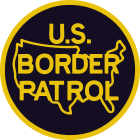United States Border Patrol
| United States Border Patrol | |
|---|---|
| Abbreviation | USBP |
|
Seal and patch of the United States Border Patrol | |
|
Badge of the United States Border Patrol | |
|
Flag of the United States Border Patrol | |
| Motto | Honor First |
| Agency overview | |
| Formed | May 28, 1924 |
| Legal personality | Governmental: Government agency |
| Jurisdictional structure | |
| Federal agency (Operations jurisdiction) | United States |
| Size | 19,000 lineal miles |
| Legal jurisdiction | INA 235 & INA 287. Title 8 USC, 18 USC, 19 USC & 21 USC |
| General nature |
|
| Specialist jurisdiction | National border patrol, security, and integrity. |
| Operational structure | |
| Headquarters | Washington, D.C., U.S. |
| Border Patrol Agents | Congress Mandated 21,370 |
| Agency executive | Mark Morgan[1], Chief, U.S. Border Patrol |
| Parent agency | U.S. Customs and Border Protection |
| Website | |
| United States Border Patrol | |
The United States Border Patrol (USBP) is an American federal law enforcement agency. Its mission is to detect and prevent illegal aliens, terrorists and terrorist weapons from entering the United States, and prevent illegal trafficking of people and contraband.[2] It is an agency within U.S. Customs and Border Protection (CBP), a component of the U.S. Department of Homeland Security (DHS).
With over 21,000 agents, the U.S. Border Patrol is one of the largest law enforcement agencies in the United States.[3]
For the first time in 92-year history of the U.S. Border Patrol, a Chief was selected from outside the agency with FBI Agent Mark Morgan being named Chief of Border Patrol in June 2016, following Michael J. Fisher's retirement.[4]
History
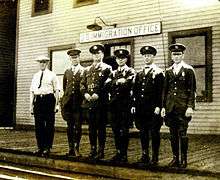
Mounted watchmen of the United States Immigration Service patrolled the border in an effort to prevent illegal crossings as early as 1904, but their efforts were irregular and undertaken only when resources permitted. The inspectors, usually called "mounted guards", operated out of El Paso, Texas. Though they never totaled more than 75, they patrolled as far west as California trying to restrict the flow of illegal Chinese immigration.
In March 1915, Congress authorized a separate group of mounted guards, often referred to as "mounted inspectors". Most rode on horseback, but a few operated automobiles, motorcycles and boats. Although these inspectors had broader arrest authority, they still largely pursued Chinese aliens trying to avoid the National Origins Act and Chinese Exclusion Act of 1882. These patrolmen were Immigration Inspectors, assigned to inspection stations, and could not watch the border at all times. U.S. Army soldiers along the southwest border performed intermittent border patrolling, but this was secondary to "the more serious work of military training." Aliens encountered illegally in the U.S. by the Army were directed to the immigration inspection stations. Texas Rangers were also sporadically assigned to patrol duties by the state, and their efforts were noted as "singularly effective".
.png)
.svg.png)

The U.S. Border Patrol was founded on May 28, 1924, as an agency of the United States Department of Labor to prevent illegal entries along the Mexico–United States border and the Canada–US border. The first Border Patrol station began operations in Detroit, Michigan in June 1924.[5] A second station in El Paso, Texas began operations in July 1924.[6] Additional operations were established along the Gulf Coast in 1927 to perform crewman control to ensure that foreign crewmen departed on the same ship on which they arrived.[7] In 1932, the Border Patrol was divided into two offices. Mexican border operations were directed from El Paso, Texas and Canadian border operations were directed from Detroit, Michigan. The Canadian border operations from Detroit employed more men than the El Paso operations along the Mexican border because of a focus on the prevention of liquor smuggling during prohibition. Franklin Delano Roosevelt's Executive Order 6166 formed the Immigration and Naturalization Service (INS) in 1933 by consolidation of the Bureau of Immigration and the Bureau of Naturalization. Following the outbreak of World War II in Europe, Border Patrol staffing doubled to 1,500 in 1940, and the INS was moved from the Department of Labor to the U.S. Department of Justice.[8] Additional stations were temporarily added along the Gulf Coast, Florida and the Eastern Seaboard during the 1960s after Fidel Castro triumphed in the Cuban Revolution and that was followed by the Cuban Missile Crisis. INS was decommissioned in March 2003 when its operations were divided between CBP, United States Citizenship and Immigration Services, and U.S. Immigration and Customs Enforcement.
In the wake of the attacks of September 11, the Border Patrol was placed under the umbrella of the Department of Homeland Security, and preventing terrorists and terrorist weapons from entering the United States was added to its mission. The Border Patrol's traditional mission continued: deterring, detecting and apprehending illegal aliens and individuals involved in the illegal drug trade who generally entered the United States at places other than through designated ports of entry. The Border Patrol also erected 33 permanent interior checkpoints near the southern border of the United States.
As of 2012, the U.S. Border Patrol employed 21,394 agents.[9] The 1,969 miles of Mexican international border was patrolled by 18,516 of those agents while 2,206 additional agents were responsible for patrolling the 5,525-mile Canadian international border; 224 agents were patrolling the coastal waters surrounding the Florida Peninsula and the island of Puerto Rico. Agents are assigned primarily to the Mexico–United States border, where they control drug trafficking and illegal immigration.[10]
Strategy
1986: Employer sanctions and interior enforcement
The Border Patrol's priorities have changed over the years. In 1986, the Immigration Reform and Control Act placed renewed emphasis on controlling illegal immigration by going after the employers that hire illegal aliens. The belief was that jobs were the magnet that attracted most illegal aliens to come to the United States. The Border Patrol increased interior enforcement and Form I-9 audits of businesses through an inspection program known as "employer sanctions". Several agents were assigned to interior stations, such as within the Livermore Sector in Northern California.
Employer sanctions never became the effective tool it was expected to be by Congress. Illegal immigration continued to swell after the 1986 amnesty despite employer sanctions. By 1993, Californians passed Proposition 187, denying benefits to illegal aliens and criminalizing illegal aliens in possession of forged green cards, identification cards, and Social Security numbers. It also authorized police officers to question non-nationals as to their immigration status and required police and sheriff departments to cooperate and report illegal aliens to the INS. Proposition 187 drew nationwide attention to illegal immigration.
Checkpoint Stations
United States Border Patrol Interior Checkpoints are inspection stations operated by the USBP within 100 miles (160 km) of a national border (with Mexico or Canada) or in the Florida Keys.[11]
El Paso Sector's Operation Hold the Line
El Paso Sector Chief Patrol Agent Silvestre Reyes started a program called "Operation Hold the Line". In this program, Border Patrol agents would no longer react to illegal entries resulting in apprehensions, but would instead be forward deployed to the border, immediately detecting any attempted entries or deterring crossing at a more remote location. The idea was that it would be easier to capture illegal entrants in the wide open deserts than through the urban alleyways. Chief Reyes deployed his agents along the Rio Grande, within eyesight of other agents. The program significantly reduced illegal entries in the urban part of El Paso, however, the operation merely shifted the illegal entries to other areas.
San Diego Sector's Operation Gatekeeper
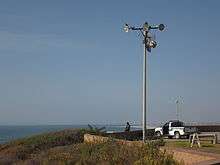
San Diego Sector tried Silvestre Reyes' approach of forward deploying agents to deter illegal entries into the country. Congress authorized the hiring of thousands of new agents, and many were sent to San Diego Sector. In addition, Congressman Duncan Hunter became a major proponent of border fencing; surplus military landing mats were obtained to use as an initial border fence.[12] Stadium lighting, ground sensors and infra-red cameras were also placed in the area. Eventually the primitive landing mat fence was replaced with a modern triple fence line[13][14] that begins over one hundred yards into the Pacific Ocean at Imperial Beach, CA and ends more than 13 miles (19 km) inland on Otay Mesa where the mountains begin. Apprehensions decreased dramatically in that area as the illegal entrant alien traffic was pushed further east into the mountains and desert in eastern San Diego County and beyond.
Tucson Sector's Operation Safeguard
Western California was no longer the hotbed of illegal entry and the smuggling traffic shifted to the mountains and deserts of eastern California and Arizona, with the area in and around the city of Nogales, AZ (currently the largest border patrol station in the United States) becoming one of busier illegal crossing areas along the border. The Border Patrol instituted the same deterrent strategy it used in San Diego in Nogales, Arizona.
Northern border
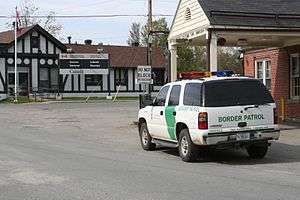
Through agency whistleblowers, Agent M. Hall and Agent R. Lindemann, it was revealed that in 2001, the Border Patrol had approximately 324 agents assigned along the Canada–United States border.[15] Northern border staffing had been increased by 1,128 agents to 1,470 agents by the end of fiscal year 2008, and is projected to expand to 1,845 by the end of fiscal year 2009, a sixfold increase. Resources that support Border Patrol agents include the use of new technology and a more focused application of air and marine assets.
The northern border sectors are (west to east): Blaine (Washington), Spokane (Washington), Havre (Montana), Grand Forks (North Dakota), Detroit (Selfridge ANGB, Michigan), Buffalo (New York), Swanton (Vermont), and Houlton (Maine).[16]
Border Patrol moves away from interior enforcement
In the 1990s, The United States Congress mandated that the Border Patrol shift agents away from the interior and focus them on the borders.
After the September 11 attacks of 2001, the Department of Homeland Security created two immigration enforcement agencies out of the defunct Immigration and Naturalization Service: U.S. Immigration and Customs Enforcement (ICE) and the U.S. Customs and Border Protection (CBP). ICE was tasked with investigations, detention and removal of illegal aliens, and interior enforcement. CBP was tasked with inspections at U.S. ports of entry and with preventing illegal entries between the port of entry, transportation check, and entries on U.S. coastal borders. DHS management decided to align the Border Patrol with CBP. CBP's Office of Field Operations is solely responsible for the nation's ports of entry, while Border Patrol maintains jurisdiction over all locations between ports of entry, giving Border Patrol agents federal arrest authority nationwide.
In July 2004, the Livermore Sector of the United States Border Patrol was closed. Livermore Sector served Northern California and included stations at Dublin (Parks Reserve Forces Training Area), Sacramento, Stockton, Salinas, San Luis Obispo, Fresno and Bakersfield. The Border Patrol also closed other stations in the interior of the United States including Roseburg, Oregon and Little Rock, Arkansas. The Border Patrol functions in these areas consisted largely of local jail and transportation terminal checks for illegal aliens. These functions were turned over to U.S. Immigration and Customs Enforcement.
The new strategy

In November 2005, the U.S. Border Patrol published an updated national strategy.[17] The goal of this updated strategy is operational control of the United States border. The strategy has five main objectives:
- Apprehend terrorists and terrorist weapons illegally entering the United States;
- Deter illegal entries through improved enforcement;
- Detect, apprehend, and deter smugglers of humans, drugs, and other contraband;
- Use "smart border" technology; and
- Reduce crime in border communities, improving quality of life.
Capabilities

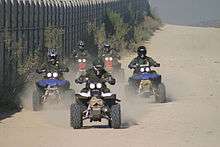
The United States border is a barely discernible line in uninhabited deserts, canyons, or mountains. The Border Patrol utilizes a variety of equipment and methods, such as electronic sensors placed at strategic locations along the border, to detect people or vehicles entering the country illegally. Video monitors and night vision scopes are also used to detect illegal entries. Agents patrol the border in vehicles, boats, aircraft, and afoot. In some areas, the Border Patrol employs horses, all-terrain motorcycles, bicycles, and snowmobiles. Air surveillance capabilities are provided by unmanned aerial vehicles.[18]
The primary activity of a Border Patrol Agent is "Line Watch". Line Watch involves the detection, prevention, and apprehension of terrorists, illegal aliens and smugglers of aliens at or near the land border by maintaining surveillance from a covert position; following up on leads; responding to electronic sensor, television systems and aircraft sightings; and interpreting and following tracks, marks, and other physical evidence. Major activities include traffic check, traffic observation, city patrol, transportation check, administrative, intelligence, and anti-smuggling activities.[10]
Traffic checks are conducted on major highways leading away from the border to detect and apprehend illegal aliens attempting to travel further into the interior of the United States after evading detection at the border, and to detect illegal narcotics.[18]
Transportation checks are inspections of interior-bound conveyances, which include buses, commercial aircraft, passenger and freight trains, and marine craft.[18]
Marine Patrols are conducted along the coastal waterways of the United States, primarily along the Pacific coast, the Caribbean, the tip of Florida, and Puerto Rico and interior waterways common to the United States and Canada. Border Patrol conducts border control activities from 130 marine craft of various sizes. The Border Patrol maintains watercraft ranging from blue-water craft to inflatable-hull craft, in 16 sectors, in addition to headquarters special operations components.[18]
Horse and bike patrols are used to augment regular vehicle and foot patrols. Horse units patrol remote areas along the international boundary that are inaccessible to standard all-terrain vehicles. Bike patrol aids city patrol and is used over rough terrain to support linewatch.[18] Snowmobiles are used to patrol remote areas along the northern border in the winter.
Expansion
In 1992, the United States Border Patrol had approximately 4,139 Patrol Agents on the job. Attrition in the Border Patrol was normally at 5%. From 1995-2001 annual attrition rose to above 10%, which was a period when the Border Patrol was undergoing massive hiring. In 2002 the attrition rate climbed to 18%. The 18% attrition was largely attributed to agents transferring to the Federal Air Marshals after 9/11. Since that time the attrition rate has decreased. Congress increased journeyman Border Patrol Agent pay from a GS-9 rate to a GS-11 rate in 2002. The Border Patrol Marine Position was created in 2009 (BPA-M). This position will be updated to a GS-12 position sometime in 2010 or 2011. Border Patrol Field Training Officers may possibly be updated in 2010 to a temporary GS-12 pay rate. In 2005, Border Patrol attrition dropped to 4% and remains in the area of 4% to 6% as of 2009.[20]
The Intelligence Reform and Terrorism Prevention Act of 2004 (signed by President Bush on December 17, 2004) authorized hiring an additional 10,000 agents, "subject to appropriation". This authorization nearly doubled the Border Patrol manpower from 11,000 to 20,000 agents by 2010.[21] At the same time, the number of illegals caught dropped from 1.2 million in 2005 to 541,000 in 2009.
In July 2005, Congress signed the Emergency Supplemental Spending Act for military operations in Iraq/Afghanistan and other operations. The act also appropriated funding to increase Border Patrol manpower by 500 Agents. In October 2005, President Bush also signed the DHS FY06 [fiscal year 2006] Appropriation bill, funding an additional 1,000 agents.
In November 2005, President George W. Bush made a trip to southern Arizona to discuss more options that would decrease Mexicans crossings at the U.S. and Mexican border. In his proposed fiscal year 2007 budget, he requested an additional 1,500 Border Patrol Agents.
The Secure Fence Act, signed by President George W. Bush on October 26, 2006, has met with much opposition. In October 2007, environmental groups and concerned citizens filed a restraining order hoping to halt the construction of the fence, set to be built between the United States and Mexico. The act mandates that the fence be built by December 2008. Ultimately, the United States seeks to put fencing around the 1,945-mile (3,130 km) border, but the act requires only 700 miles (1,100 km) of fencing. DHS secretary Michael Chertoff has bypassed environmental and other oppositions with a waiver that was granted to him by Congress in Section 102 of the act, which allows DHS to avoid any conflicts that would prevent a speedy assembly of the fence.[22][23]
This action has led many environment groups and landowners to speak out against the impending construction of the fence.[24] Environment and wildlife groups fear that the plans to clear brush, construct fences, install bright lights, motion sensors, and cameras will scare wildlife and endanger the indigenous species of the area.[25] Environmentalists claim that the ecosystem could be affected because a border fence would restrict movement of all animal species, which in turn would keep them from water and food sources on one side or another. Desert plants would also feel the impact, as they would be uprooted in many areas where the fence is set to occupy.[26]
Property owners in these areas fear a loss of land. Landowners would have to give some of their land over to the government for the fence. Citizens also fear that communities will be split. Many students travel over the border every day to attend classes at the University of Texas at Brownsville. Brownsville mayor Pat Ahumada favors alternative options to a border fence. He suggests that the Rio Grande be widened and deepened to provide for a natural barrier to hinder illegal aliens and drug smugglers.[27]
Special Operations Group

- Border Patrol Tactical Unit (BORTAC)
- Border Patrol, Search, Trauma and Rescue (BORSTAR)
- Mobile Response Team (MRT)
Other specialized programs
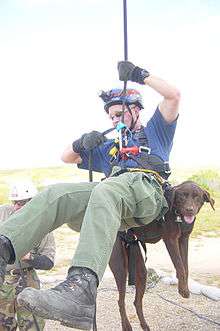
In 2007, the U.S. Border Patrol created the Special Operations Group (SOG) headquartered in El Paso, TX to coordinate the special operations units of the agency.[28]
The U.S. Border Patrol has a number of other specialized programs and details. Marine Patrol - In the riverine environments of the northern and southwestern borders of the continental United States, the Border Patrol conducts border control activities from the decks of marine craft of various sizes. Since 2006, the U.S. Border Patrol has relinquished its littoral law enforcement missions in the Great Lakes and territorial seas to the Office of Air and Marine. The U.S. Border Patrol maintains over 130 vessels, ranging from blue-water craft to inflatable-hull craft, in 16 sectors, in addition to Headquarters special operations components.

[29] K9 Units, Mounted Patrol, Bike patrol, Sign-cutting (tracking), Snowmobile unit, Infrared scope unit, Intelligence, Anti-smuggling Investigations Unit (ASU/DISRUPT, Border Criminal Alien Program, Multi-agency Anti-Gang Task Forces (regional & local units), Honor Guard, Pipes and Drums, Chaplain, Peer Support, Mobile Surveillance Unit.
Lifesaving
"Operation Gatekeeper" was launched in 1994 to stop migrants from crossing illegally into the United States. The strategy included increased enforcement and extensive fencing near border cities, with the twofold purpose of deflecting migrants to remote areas where they could more easily be detected and apprehended, as well as using the formidable mountains, deserts, and Rio Grande as a deterrent to easy passage.[30] The newly erected Mexico–United States barrier—which at some remote locations is no more than a fence—has also forced migrants and human traffickers to seek out remote desert locations in California, Arizona, New Mexico and Texas where they may attempt crossing.[31][32] The "funnel effect" created by both these strategies has contributed to the deaths of thousands of migrants, whose remains are often found in the hot desert or freezing mountains.[33]
As early as 1998, the former Immigration and Naturalization Service implemented the Border Safety Initiative in response to concerns about the number of migrants injured or killed while attempting to cross the border. It was noted that Border Patrol agents routinely supplied water, food, and medical care to migrants.[34] That same year, Border Patrol, Search, Trauma and Rescue (BORSTAR), a specialized unit trained in emergency search and rescue, was established with the purpose of assisting injured or stranded migrants at remote locations.[35]
In 2002, the first "rescue beacons" were installed in desert areas considered especially dangerous.[36] The beacons are solar powered and highly visible, and have a button which alerts Border Patrol agents by radio signal, after which a helicopter or ground unit is dispatched.[37] U.S. Senator Bill Frist commented in 2006: "these beacons, I believe, are an absolutely vital link in our border security system... We know that beacons work: CBP has already saved dozens of people based entirely on beacon alerts."[36] The Border Patrol frequently publishes reports about stranded and injured individuals rescued at beacon locations.
During a 12-month period in 2011-12, Border Patrol agents made 1,312 rescues along the Mexico-United States border, nearly half occurring in the Tucson Sector.[38]
Border Patrol Sectors
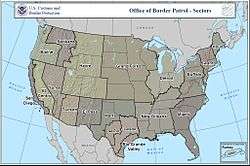
There are 20 Border Patrol sectors, each headed by a Sector Chief Patrol Agent.
Northern Border (West to East)
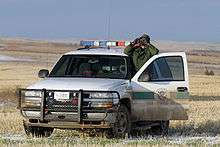
- Blaine Sector (Western Washington, Oregon, and Alaska.) - stations; Bellingham, Blaine, Port Angeles, Sumas.
- Spokane Sector (Eastern Washington State, Idaho and Western Montana) - stations: Oroville, WA; Curlew, WA; Colville, WA; Metaline Falls, WA; Bonners Ferry, ID; Eureka, MT; Whitefish, MT
- Havre Sector Eastern (Montana)
- Grand Forks Sector (North Dakota) Stations; Duluth MN, Grand Forks ND, Grand Marais, International Falls, Pembina ND, Portal, Warroad. Grand Forks is the only Sector to Deploy the new Resident Agent Program. This program was launched in late 2009 early 2010. The Resident Agent Program allows Border Patrol agents to work with Local, County, State, and other Federal Agencies to gain maximum effectiveness over such vast area.
- Detroit Sector (Selfridge Air National Guard Base, Michigan) - stations; Downtown Detroit, Marysville, Gibraltar, Sault Sainte Marie, Sandusky Bay.
- Buffalo Sector (New York) - stations; Buffalo, NY, Erie, PA, Niagara Falls, Oswego, Rochester, Wellesley Island.
- Swanton Sector (Vermont)(New Hampshire)
- Houlton Sector (Maine)
Southern Border (West to East)
- San Diego Sector, stations; Imperial Beach, Chula Vista, Brown Field, El Cajon, Campo, Boulevard sub-station, Temecula, and San Clemente (San Diego County, California)
- El Centro Sector, stations; El Centro, Calexico, (Imperial County, California) Indio, and Riverside (Riverside County, California)
- Yuma Sector (Western Arizona) - stations; Wellton, Yuma, Blythe
- Tucson Sector (Eastern Arizona) - stations; Ajo, Casa Grande, Tucson, Nogales, Sonoyta, Naco, Willcox, and Douglas.
- El Paso Sector (El Paso County, Texas and New Mexico) - stations; El Paso, Fabens (Clint), Fort Hancock, Ysleta, Alamogordo, Albuquerque, Deming, Las Cruces, Lordsburg, Santa Teresa, Truth or Consequences.
- Marfa Sector (Big Bend Area of West Texas) - stations; Alpine, Amarillo, Big Bend, Fort Stockton, Lubbock, Marfa, Midland, Pecos, Presidio, Sanderson, Sierra Blanca, Van Horn
- Del Rio Sector (Del Rio, Texas) - stations; Abilene, Brackettville, Carrizo Springs, Comstock, Del Rio, Eagle Pass North, Eagle Pass South, Rocksprings, San Angelo, Uvalde
- Rio Grande Valley Sector (Rio Grande Valley Area) - stations; Brownsville, Corpus Christi, Falfurrias, Fort Brown, Harlingen, Kingsville, McAllen, Rio Grande City, Weslaco
- Laredo Sector (South Texas) - stations; Cotulla, Dallas, Freer, Hebbronville, Laredo North, Laredo South, Laredo West, San Antonio, Zapata
- New Orleans Sector (Louisiana, Mississippi, Alabama, and West Florida)
- Miami Sector (Florida East and South)
Caribbean
- Ramey Sector (Puerto Rico and U.S. Virgin Islands) - station; Aguadilla. It's the only Border Patrol Sector located outside the continental United States
Training
All Border Patrol agents spend a minimum of 13 Weeks at the Border Patrol Academy (if they are fluent in Spanish) in Artesia, New Mexico, which is a component of the Federal Law Enforcement Training Center (FLETC). Those who are not fluent in Spanish spend an additional eight weeks at the Academy for a total of 21 weeks. Border Patrol Agent Trainees are instructed in courses including; criminal law, nationality law, and administrative immigration law, police sciences, self-defense and arrest techniques, firearms training with pistol, shotgun and rifle, police vehicle driving, and other Border Patrol / federal law enforcement subjects.
Once they arrive back at their duty station, Trainees then must graduate from the Field Training Officer (FTO) program, an on-the-job training program, which varies in length from a minimum of 12 weeks to a maximum of over 16 weeks long, depending on the practical demands of the duty station and local management. They must also successfully complete the Post Academy Training Program, an extension of the Border Patrol Academy where Trainees complete additional classroom-based training over the course of their first nine months back at their duty station.
The marksmanship skills of Border Patrol agents ranks among the best in the United States. At the National Police Shooting Championships in 2012, Border Patrol agents placed first, second or third in each of the 29 shooting matches.[39]
Appearance
Uniforms
The Border Patrol currently wears the following types of uniforms:
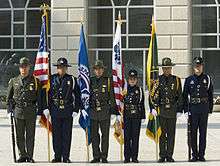
- Summer Dress uniform – The summer dress uniform consists of a short-sleeve, olive-green dress shirt (which may or may not have blue shoulder straps), brass nameplate, badge, olive-green slacks with a blue stripe running the length of the seam, and black dress shoes or dress boots. A green, straw campaign hat is worn with this uniform.
- Winter Dress uniform – The winter dress uniform consists of a long-sleeve, olive green dress shirt, navy-blue clip-on tie with a brass tie tack, olive-green ike jacket with blue accents (shoulder straps and cuffs), brass nameplate, badge, olive-green slacks with a blue stripe running the length of the seam, and black dress shoes or dress boots. a green, felt campaign hat with a black, leather hat band is worn with this uniform.
- Ceremonial Dress uniform - Worn primarily by border patrol honor guard agents, the ceremonial dress uniform is roughly identical to the winter dress uniform, with the exception that a tunic is worn with this uniform, rather than an ike jacket. White, cloth gloves are also worn with this uniform.
- Rough duty uniform – The rough duty uniform consists of a green, long-sleeve or short-sleeve work shirt, green cargo pants, and black work boots. a green baseball cap is typically worn with this uniform.
- There are also specialized rough duty uniforms for horse patrol and bike patrol agents.
- Highland Uniform - Worn by members of the United States Border Patrol Pipes and Drums in the performance of their official duties, this uniform includes a kilt made of the official Border Patrol Tartan, custom made ceremonial coat, glengarry, sporran and spats.
- Organization patches – The Border Patrol wears two:
- The CBP patch is worn on the right sleeves of the uniform. It contains the DHS seal against a black background with a "keystone" shape. A "keystone" is the central, wedge-shaped stone in an arch, which holds all the other stones in place.
- Border Patrol agents retain the circular legacy Border Patrol patch, which is worn on the left sleeve.
The Border Patrol uniform is getting its first makeover since the 1950s to appear more like military fatigues and less like a police officer's duty garb.[40] Leather belts with brass buckles are being replaced by nylon belts with quick-release plastic buckles, slacks are being replaced by lightweight cargo pants, and shiny badges and nameplates are being replaced by cloth patches.
Border Patrol (OBP) ranks and insignia
| Location | Title | Collar insignia | Shoulder ornament | Pay grade |
|---|---|---|---|---|
| Border Patrol Headquarters | Chief of the Border Patrol | |
Senior Executive Service (SES) | |
| Deputy Chief of the Border Patrol | |
SES | ||
| Division Chief | |
SES | ||
| Deputy Division Chief | |
GS-15, General Schedule | ||
| Associate Chief | |
GS-15 | ||
| Assistant Chief | |
GS-14 | ||
| Operations Officer (Non-supervisory) | |
GS-13 | ||
| Border Patrol Sectors | Chief Patrol Agent (CPA) | |
SES or GS-15 | |
| Deputy Chief Patrol Agent (DCPA) | |
SES or GS-15 | ||
| Division Chief/ACTT Director | |
GS-15 | ||
| Executive Officer/Assistant Chief Patrol Agent (ACPA) | |
GS-14 | ||
| Special Operations Supervisor (SOS) | |
GS-13 | ||
| Operations Officer (Non-supervisory) | |
GS-13 | ||
| Supervisory Border Patrol Agent (SBPA) | |
GS-13 | ||
| Border Patrol Agent - Intelligence (BPA-I) | |
GS-12 | ||
| Border Patrol Stations | Patrol Agent in Charge (PAIC) | |
GS-13, 14, 15 | |
| Deputy Patrol Agent in Charge (DPAIC) | |
GS-14 or GS-13 | ||
| Watch Commander (WC) | |
GS-14 or GS-13 | ||
| Special Operations Supervisor (SOS) | |
GS-13 | ||
| Supervisory Border Patrol Agent (SBPA) | |
GS-13 | ||
| Border Patrol Agent - Intelligence (BPA-I) | |
GS-12 | ||
| Border Patrol Agent (BPA) | |
GL-5, 7, 9, GS-11, 12 | ||
| Border Patrol Academy | Chief Patrol Agent (CPA) | |
GS-15 | |
| Deputy Chief Patrol Agent (DCPA) | |
GS-15 | ||
| Assistant Chief Patrol Agent (ACPA) | |
GS-14 | ||
| Training Operations Supervisor (TOS) | |
GS-14 | ||
| Supervisory Border Patrol Agent (Senior Instructor) | |
GS-13 | ||
| Supervisory Border Patrol Agent (Instructor) | |
GS-13 | ||
| Border Patrol Agent (Detailed Instructor) | |
GS-11, 12 |
Border Patrol Shoulder ornaments
Awards
| Newton-Azrak Award for Heroism | Chiefs Commendation Medal | Purple Cross Wound Medal | 75th Anniversary Commemorative Medal | |
|---|---|---|---|---|
| |
 |
|
 | |
Current Heroism Award | Awarded from 2002–2004 | Current Wound Award | No Longer worn | |
Newton-Azrak Award for Heroism
The Border Patrol's highest honor is the Newton-Azrak Award for Heroism. This Award is bestowed to Border Patrol Agents for extraordinary actions, service; accomplishments reflecting unusual courage or bravery in the line of duty; or an extraordinarily heroic or humane act committed during times of extreme stress or in an emergency.
This award is named for Border Patrol Inspectors Theodore Newton[41] and George Azrak,[42] who were murdered by two drug smugglers in San Diego County in 1967.
Border Patrol Uniform Devices
| Tactical Unit (BORTAC) | Search and Rescue Unit | Honor Guard | Pipes and Drums Cap Badge | K-9 Handler | Chaplain | Field Training Officer | Peer Support | |
|---|---|---|---|---|---|---|---|---|
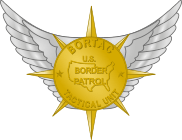 |
|
|
|
|
 |
|
| |
Equipment
Weapons

Border Patrol agents are issued the H&K P2000 double action LEM (Law Enforcement Modification) pistol in .40 S&W caliber. It can contain as many as 13 rounds of ammunition (12 in the magazine and one in the chamber). Up until 1994 the Border Patrol issued its Patrol Agents a .357 Magnum revolver as their duty sidearm, a Smith & Wesson or Ruger model large frame, six shot revolver. The Border Patrol preferred this weapon because it did not jam in harsh conditions, like those of the southwestern border, and also because of the strong "stopping" power of the .357 Magnum cartridge. Although up until 1994 Patrol Agents could purchase a weapon from the agency list of approved authorized personal weapons for duty carry. This list included the Glock Models 17 and 19 pistols in 9mm, the SIG Sauer P220 pistol in .45 ACP caliber, the Colt Python .357 Magnum revolver, and the Smith & Wesson Model 19/66 .357 Magnum revolver. The Border Patrol adopted the Beretta Model 96D, a .40 S&W caliber semi-automatic pistol (modified for Double-Action Only) (with 11-round capacity magazines) as its duty issue sidearm in 1995. The .40 S&W caliber jacketed hollow-point cartridge was adopted because of its excellent "stopping" power and its superior ballistic characteristics over the 9mm cartridge. In late 2006 the H&K P2000 pistol was adopted as the Border Patrol's primary duty sidearm. The H&K Model USP Compact pistol, H&K Model P2000SK (sub-compact) and Beretta M96D .40 S&W caliber pistols are authorized as secondary sidearms.
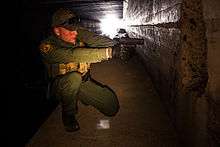
Like many other law enforcement agencies, the 12 gauge Remington Model 870 is the standard pump-action shotgun. The Border Patrol issue Model 870 has been modified by Scattergun Technologies to Border Patrol specifications including: an 14-inch barrel, a five-shot capacity magazine, a composite stock with pistol grip, and night sights with a tactical "ghost-ring" rear sight. The old Border Patrol "anti-bandit" units used to use a 12-gauge, semi-automatic shotgun with a sawed-off barrel. This weapon had the designated name of a "Sidewinder." The USBP anti-bandit units were decommissioned in the late 1980s.
Border Patrol agents also commonly carry the .223 caliber Colt M4 Carbine (M4A1) and the H&K UMP .40 caliber submachine gun. The .308 caliber M14 rifle is used for ceremonial purposes and by agents who are qualified with the rifle and BORTAC.
As less than lethal options, the Border Patrol uses the FN 303 Launcher. The FN 303 fires plastic pellet balls containing OC (Oleoresin Capsicum) Pepper dust. The plastic pellet balls burst on impact spraying the suspect with OC Pepper dust and also act as an impact projectile. The Border Patrol also issues its agents OC Pepper spray canisters, tasers and a collapsible/telescopic (or telescoping) steel police baton.
Transportation



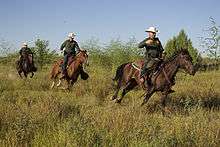
Unlike in many other law enforcement agencies in the United States, the Border Patrol operates over 10,000 SUVs and pickup trucks, which are known for their capabilities to move around in any sort of terrain. These vehicles may have individual revolving lights (strobes or LEDs) and/or light bars and sirens and/or have their bumpers removed or have off road suspension and tires. An extensive modernization drive has ensured that these vehicles are equipped with wireless sets in communication with a central control room. Border Patrol vehicles may also have equipment such as emergency first aid kits. Some sectors make use of sedans like the Ford Crown Victoria Police Interceptor or the Dodge Charger as patrol cars or high speed "interceptors" on highways. The border patrol has approx 2,000 sedans. The Border Patrol also operates all-terrain vehicles, motorcycles, snowmobiles, and small boats in riverine environments.
In 2005, all Border Patrol and ICE aircraft operations were combined under CBP's Office of Air and Marine. All CBP vessel operations within the Customs Waters and on the high seas are conducted by Marine Interdiction Agents of the Office of Air and Marine.
Color schemes of Border Patrol vehicles are either a long green stripe running the length of the vehicle (older vehicles) or a broad green diagonal stripe (newer vehicles) on the door. Most Border Patrol vehicles are painted predominantly white. During the 1960s to mid-1980s Border Patrol vehicles were painted a light green.
The Border Patrol also extensively uses horses for remote area patrols. As of 2005, the U.S. Border Patrol has 205 horses. Most are employed along the Mexico–United States border. In Arizona, these animals are fed special processed feed pellets so that their wastes do not spread non-native plants in the national parks and wildlife areas they patrol.[43]
Killed in the line of duty
Since 1904, the Border Patrol has lost 123 officers in the line of duty, more than any other federal law enforcement agency during that time period.[44]
| Cause of death | Number of officers |
|---|---|
| Aircraft accident | 14 |
| Assault | 2 |
| Automobile accident | 33 |
| Drowned | 4 |
| Duty-related illness | 3 |
| Fall | 4 |
| Gunfire | 31 |
| Gunfire (Accidental) | 4 |
| Heart attack | 6 |
| Heat exhaustion | 2 |
| Motorcycle accident | 3 |
| Stabbed | 2 |
| Struck by train | 5 |
| Struck by vehicle | 4 |
| Vehicle pursuit | 2 |
| Vehicular assault | 4 |
Armed incursions
On August 7, 2008, Mexican troops crossed the border into Arizona and held a U.S. Border Patrol Agent at gunpoint. Agents stationed at Ajo, Arizona said that the Mexican soldiers crossed the border into an isolated area southwest of Tucson and pointed rifles at the agent, who has not been identified. The Mexicans withdrew after other U.S. agents arrived on the scene.
On March 14, 2000 16 Mexican soldiers in two humvees chased a Border Patrol agent near Santa Teresa, New Mexico, while another agent came under gunfire. Backup arrived and the soldiers were detained. The Mexican government said the soldiers got lost. The U.S. State Department ordered them sent back to Mexico along with their weapons.[45]
Death threats
On numerous occasions USBP agents have been fired upon from the Mexican side of the international border. Intelligence gathering has discovered bounties being placed on Patrol Agents to be paid by criminal smuggling organizations upon the confirmed murder or kidnapping of a U.S. Border Patrol Agent. In 2008, intelligence learned of a two-million-dollar contract for the murder of a Border Patrol Agent. In 2009 Border Patrol Agent Rosas was murdered in an ambush while on patrol; a bounty may have been paid to the assassins.[46]
Criticisms
Ramos and Compean
In February 2005, Border Patrol Agents Ignacio Ramos and Jose Compean were involved in an incident while pursuing a van in Fabens, Texas. The driver, later identified as Aldrete Davila, was shot by Agent Ramos during a scuffle. Davila escaped back into Mexico, and the agents discovered that the van contained a million dollars worth of marijuana (about 750 pounds). None of the agents at the scene orally reported the shooting, including two supervisors: Robert Arnold, first-line Supervisor and Jonathan Richards, a higher ranking Field Operations Supervisor.[47] The Department of Homeland Security opened up an internal affairs investigation into the incident.[48][49][50] Ramos and Compean were charged with multiple crimes. Ramos was convicted of causing serious bodily injury, assault with a deadly weapon, discharge of a firearm in relation to a crime of violence, and a civil rights violation.[51] Compeán was found guilty on 11 counts, including discharging a firearm during the commission of a violent crime, which by itself carries a federally mandated 10-year minimum sentence. Without that charge, both agents involved would have received far shorter sentences. Ramos was sentenced to 11 years and a day in prison and Compean to 12 years.[52] Jonathan Richards was promoted to the Patrol Agent in Charge of the Santa Teresa, New Mexico Border Patrol Station soon after the incident.[53] On January 19, 2009, President Bush commuted the sentences of both Ramos and Compean, effectively ending their prison term on March 20, 2009,[54] and they were released on February 17, 2009.[55] The case generated widely differing opinion among various commentators and advocacy groups: civil libertarians asserted the agents used illegal and excessive force, while advocates of tighter border control defended the agents actions.[56]
Death of Sergio Hernandez
Sergio Adrian Hernandez was a teenager who was shot once and killed on 7 June 2010 by Border Patrol agents under a bridge crossing between El Paso, Texas and Juarez, Mexico.[57]
Border Patrol agents claimed that there was a mob that was throwing stones at them.[57] They also claimed that Hernandez was trying to cross the U.S. border and that he had already tried to do so in the past.
On June 10 the Mexican president Felipe Calderón called on the United States to launch a "thorough, impartial" probe into the deaths of two Mexican nationals, including the 14-year-old Hernandez, at the hands of U.S. border police: "I demand the United States government conduct a thorough, impartial ... investigation, concluding with an establishment of the facts and punishment of the culprits."[58]
On June 12, 2010 the television network Univision aired cellphone video footage of the incident, after which Mexican legislators called for the extradition of the officer accused of the shooting.[59][60]
Death of Jose Antonio Elena Rodriguez
As the Washington Office on Latin America's Border Fact Check site points out, a similar incident occurred in October 2012 when 16-year-old Jose Antonio Elena Rodriguez was killed in downtown Nogales, Mexico when a Border Patrol Agent, Lonnie Swartz, opened fire at a group of people allegedly throwing rocks at him; Rodriguez was shot seven times in the back. WOLA and other human rights organizations assert that "...[L]aw enforcement experience offers a series of non-lethal responses to rock throwing incidents along the U.S.-Mexico border," such as pepper ball launchers.[61] In September 2015, Swartz was indicted on the charge of second-degree murder.[62]
Ineffectiveness
In 2006, a documentary called The Illegal Immigration Invasion[63] linked the scale of illegal immigration into the United States chiefly to the ineffectiveness of the Border Patrol. The film claimed that this is due to the lack of judicial powers of the Border Patrol and the effective hamstringing of the agency by the federal government. The film interviews people that deal with illegal immigration on a daily basis, as well as local citizens living in the border areas.
Allegations of abuse
Various civil society and human rights organizations have alleged that abuses of migrants by Border Patrol agents occur frequently:
- Between 2010 and 2011 alleged excessive use of force by Border Patrol and Field Operations agents led to the death of six Mexican citizens. A PBS report, Crossing the Line, released in July 2012, profiled the case of Anastasio Hernandez-Rojas, who died after being beaten and then shocked by a Taser by a group of CBP officers, not Border Patrol at the San Ysidro port of entry near San Diego in May 2010.[64] In 2012, in a letter to President Obama posted on the website of the Washington Office on Latin America, 118 civil society organizations criticized the Border Patrol for failing to thoroughly investigate the incident and stated that the Border Patrol "is operating with very little transparency and virtual impunity, especially in the southern border region where Border Patrol and other CBP agents regularly violate the human and civil rights of those who call the border region home."[65]
- From 2008-2011, the Arizona organization No More Deaths interviewed nearly 13,000 migrants who had been in Border Patrol custody, in the Arizona border towns of Naco, Nogales, and Agua Prieta. Their report, A Culture of Cruelty, documents alleged abuses including denial of or insufficient water and food; failure to provide medical treatment; verbal, physical and psychological abuse; separation of family members and dangerous repatriation practices. In February 2012, Border Patrol Chief Michael Fisher stated in congressional testimony that the Border Patrol takes allegations of abuse seriously.[66] However, No More Deaths testified before the Inter-American Commission of Human Rights in March 2012 and stated that in spite of raising their concerns for several years, “the agency has taken the position that such abuses simply do not occur.”[64]
- There are allegations of abuse by the United States Border Patrol such as the ones reported by Jesus A. Trevino, that concludes in an article published in the Houston Journal of International Law (2006) with a request to create an independent review commission to oversee the actions of the Border Patrol, and that creating such review board will make the American public aware of the "serious problem of abuse that exists at the border by making this review process public" and that "illegal immigrants deserve the same constitutionally-mandated humane treatment of citizens and legal residents".[67]
- In 1998, Amnesty International investigated allegations of ill-treatment and brutality by officers of the Immigration and Naturalization Service, and particularly the Border Patrol. Their report said they found indications of human rights violations during 1996, 1997 and early 1998.[68]
- An article in Social Justice by Michael Huspek, Leticia Jimenez, Roberto Martinez (1998) cites that in December 1997, John Case, head of the INS Office of Internal Audit, announced at a press conference that public complaints to the INS had risen 29% from 1996, with the "vast majority" of complaints emanating from the southwest border region, but that of the 2,300 cases, the 243 cases of serious allegations of abuse were down in 1997. These serious cases are considered to be distinct from less serious complaints, such as "verbal abuse, discrimination, extended detention without cause."[69]
Corruption
Incidences of corruption in the U.S. Border Patrol include:
- Pablo Sergio Barry, an agent charged with one count of harboring an illegal alien (8 U.S.C. § 1324),[70] three counts of false statements, and two counts of making a false document.[71] He pleaded guilty.[72]
- Christopher E. Bernis, an agent indicted on a charge of harboring an illegal alien for nine months while employed as a U.S. Border Patrol Agent.[73]
- Jose De Jesus Ruiz, an agent whose girlfriend was an illegal alien, he was put on administrative leave pending an investigation.[73]
- Oscar Antonio Ortiz, an illegal alien[74] who used a fake birth certificate to get into the Border Patrol admitted to smuggling more than 100 illegal aliens into the U.S., some of them in his government truck,[75] and was helping to smuggle illegal aliens and charged with conspiring with another agent to smuggle aliens.
- An unidentified patrol agent who was recorded on a wire tap stating that he helped to smuggle 30 to 50 aliens at a time.[74]
National Border Patrol Council
National Border Patrol Council (NBPC) is the labor union which represents over 17,000 Border Patrol agents and support staff. The NBPC was founded on November 1, 1965, and its parent organization is the American Federation of Government Employees, AFL-CIO. The NBPC's executive committee is staffed by current and retired Border Patrol agents and, along with its constituent locals, employs a staff of a dozen attorneys and field representatives. The NBPC is associated with the Peace Officer Research Association of California Legal Defense Fund|California’s Legal Defense Fund.[76] The president of the NBPC is Brandon Judd.
National Border Patrol Museum
The National Border Patrol Museum is located in El Paso, Texas. It exhibits uniforms, equipment, photographs, guns, vehicles, airplanes, boats, and documents which depict the historical and current sector operations throughout the United States. The museum is a private, not-for-profit corporation funded by donations. Admission is free, and there is a gift shop onsite.
Border Patrol Foundation
The Border Patrol Foundation was founded in 2009 to assist the survivors of agents killed in the line of duty. The foundation provides financial support to immediate family members, peer family support, and a scholarship to eligible children. The foundation recognizes community leaders who have supported the families of fallen agents, and supports programs to improve awareness of the risks faced by agents.[77] The foundation’s volunteers have served with the Border Patrol or are professionals, friends or family, while the foundation's Board of Directors are retired agents and supporters. The foundation is attempting to expand its services into the area grief education and support for those injured in the line of duty.
In popular culture
Books
- Border Patrol, by Alvin Edward Moore.
- Bleeding Borders, by Steve Arthur Timper
- The Border Patrol, by Deborah Wells Salter.
- EWI: Entry Without Inspection, by Fortuna Testarona Valiente.
- Tracks in the Sand: A Tale of the Border Patrol, by Kent E Lundgren.
- On The Line: Inside the U.S. Border Patrol, by Alex Pacheco and Erich Krauss.
- Patrolling Chaos: The U.S. Border Patrol in Deep South Texas, by Robert Lee Maril.
- The U.S. Border Patrol: Guarding the Nation, by Connie Collwell Miller.
- My Border Patrol Diary: Laredo, Texas, by Dale Squint.
- Holding the Line: War Stories of the U.S. Border Patrol, by Gerald Schumacher.
- The Border Patrol Ate My Dust, by Alicia Alarcon, Ethriam Cash Brammer, and Ethriam Cash Brammer de Gonzales.
- The Border: Exploring the U.S.-Mexican Divide, by David J. Danelo.
- Beat The Border: An Insider's Guide to How the U.S. Border Works and How to Beat It, by Ned Beaumont.
- West of the Moon: A Border Patrol Agent's Tale, by D.B. Prehoda.
- The Journey: U.S. Border Patrol & the Solution to the Illegal Alien Problem, by Donald R. Coppock.
- Border Patrol: With the U.S. Immigration Service on the Mexican boundary, 1910-54, by Clifford Alan Perkins.
- Border Patrol: How U.S. Agents Protect Our Borders from Illegal Entry, by Carroll B. Colby.
- In Mortal Danger: The Battle for America's Border and Security, by Tom Tancredo.
- Border Songs, by Jim Lynch.
- Crossing the Wire, by Will Hobbs.
Film
- Border Patrolman, a 1936 film in which Border Patrolman Bob Wallace, played by George O'Brien, resigns in protest after being humiliated by the spoiled granddaughter of a millionaire.
- Border Patrol, a 1943 film starring William C. Boyd, Andy Clyde, George Reeves, and Robert Mitchum.
- Borderline, a 1950 film noir starring Fred MacMurray about drug smuggling across the Mexico-U.S. border.
- Border Patrol, a 1959 television series starring Richard Webb as the fictitious deputy chief of the U.S. Border Patrol.
- Borderline, a 1980 movie starring Charles Bronson about a Border Patrol Agent in charge of a station located in the hills southeast of San Diego, near the Mexico-U.S. border. Bronson's character and the agents under his command pursue and apprehend a violent human trafficker/smuggler played by Ed Harris who murdered a veteran patrol agent, portrayed by Wilford Brimley, who had intercepted the smuggler one evening bringing in a shipment of illegal aliens across the border. Their investigation leads to the breaking up of the vicious smuggling operation run by Harris's character.
- Border Cop, a 1980 film starring Telly Savalas.
- The Border, a 1982 film starring Jack Nicholson as a patrol agent working on the Mexico-U.S. border.
- El Norte, a 1983 film about the plight of Central American Indian peasants traveling to the Mexico-U.S. border.
- Flashpoint, a 1984 film starring Kris Kristofferson, Treat Williams, Rip Torn, and Kurtwood Smith.
- Last Man Standing, a 1996 film starring Bruce Willis as a professional gunman and Ken Jenkins as Texas Ranger Captain Tom Pickett who is investigating the murder of an unnamed patrol inspector (played by Larry Holt) in the town where Willis's character is working.
- Men in Black, a 1997 science fiction comedy action film starring Tommy Lee Jones, Will Smith and Vincent D'Onofrio. The Border Patrol is portrayed as Immigration Inspectors in an unflattering portrayal.
- The Gatekeeper, a 2002 film by John Carlos Frey about the struggles of migrants at the Mexico-U.S. border.
- The Three Burials of Melquiades Estrada, a 2005 film by Tommy Lee Jones about the accidental killing of an illegal Mexican alien by a Border Patrol Agent.
- The Shepherd: Border Patrol, a 2007 film starring Jean-Claude Van Damme.
- Linewatch, a 2008 film starring Cuba Gooding, Jr., as a Border Patrol agent defending his family from a group of Los Angeles gang members involved in narcotics importation.
Documentaries
- Border Patrol: American's Gatekeepers, by A&E Network with former U.S. Attorney General Janet Reno.
- Investigative Reports: Border Patrol: America's Gatekeepers, by A+E Networks Investigates.
- History the Enforcers: Border Patrol, by the History Channel.
- Border Wars, a "reality" television program produced by the National Geographic Channel.
- Run For Your Life, a Canadian Broadcasting Corporation documentary about the dangers faced by young Hondurans aboard a freight train headed to the Mexico-U.S. border, where they will seek illegal entry.
- Under Siege: America's Northern Border by Discovery Channel. A 2013 documentary about the efforts and difficulties of agents to prevent illegal cross-border activities in the Detroit, Michigan area.
See also
- Border control
- Border Protection Personnel
- Border Protection, Anti-terrorism and Illegal Immigration Control Act of 2005
- Canada–United States border
- CBP Office of Air and Marine
- CBP Office of Field Operations
- Diplomatic Security Service (DSS), U.S. State Department
- Federal law enforcement in the United States § List of agencies and units of agencies
- General Atomics MQ-9 Reaper
- Ignacio Ramos
- Illegal immigration to the United States
- Mexico–United States barrier
- Minuteman Project
- National Border Patrol Museum
- No More Deaths
- Operation Gatekeeper
- U.S. Customs and Border Protection
- U.S. Immigration and Customs Enforcement
References
- ↑ "CBP Commissioner R. Gil Kerlikowske Announces Chief of the U.S. Border Patrol | U.S. Customs and Border Protection". 20 June 2016.
- ↑ "Border Patrol Overview: Mission". U.S. Customs and Border Protection. Jan 5, 2011.
- ↑ "On a Typical Day in Fiscal Year 2011" (PDF). U.S. Customs and Border Protection. Archived from the original (PDF) on 16 February 2013. Retrieved 21 September 2016.
- ↑ Kerlikowske, R. Gil (June 20, 2016). "CCBP Commissioner R. Gil Kerlikowske Announces Chief of the U.S. Border Patrol". U.S. Customs and Border Protection.
- ↑ "Detroit Station | U.S. Customs and Border Protection". www.cbp.gov. Retrieved 2016-09-21.
- ↑ "El Paso Sector Texas | U.S. Customs and Border Protection". www.cbp.gov. Retrieved 2016-09-21.
- ↑ "Detroit Welcome". CBP.
- ↑ "A History of the United States Border Patrol". National Border Patrol Museum. Retrieved 2013-04-10.
- ↑ GOP House Approves CR Allowing Obama to Continue Paring Back Border Patrol. CNS News. Retrieved on 2013-07-23.
- 1 2 "Who we are and what we do". CPB.gov. U.S. Customs and Border Protection. 2008-09-03. Retrieved 2009-06-01.
- ↑ Starr, Tina (28 April 2010). "Mexican farmworker's life like living in a "golden cage"". Barton, Vermont: the Chronicle. p. 13.
- ↑ Broder, John M. (2005-07-04). "With Congress's Blessing, a Border Fence May Finally Push Through to the Sea". The New York Times. ISSN 0362-4331. Retrieved 2015-12-08.
- ↑ Engber, Daniel (2006-09-25). "What's a Double-Layer Fence?". Slate. ISSN 1091-2339. Retrieved 2015-12-08.
- ↑ "Border Control: Revised Strategy Is Showing Some Positive Results". www.gao.gov. Retrieved 2015-12-08.
- ↑ Border Patrol Agrees To Reinstate Whistleblowers. CNS News. Retrieved on 2013-07-23.
- ↑ "Border Patrol Sectors | U.S. Customs and Border Protection". www.cbp.gov. Retrieved 2016-09-21.
- ↑ "National Border Patrol Strategy" (PDF). Archived from the original (PDF) on November 12, 2005. Retrieved November 28, 2005.
- 1 2 3 4 5 "Border Patrol overview". CPB.gov. U.S. Customs and Border Protection. 2008-08-22. Retrieved 2009-06-01.
- ↑ Woodard, Colin (January 9, 2011), "Far From Border, U.S. Detains Foreign Students", The Chronicle of Higher Education
- ↑ Nuñez-Neto, Blas (2006-01-25). Border security: The role of the U.S. Border Patrol (PDF). Congressional Research Service. p. 35. Retrieved 2009-06-01.
- ↑ Kelly, Erin (3 June 2010). "Governor:Ariz. besieged". Melbourne, Florida: Florida Today. pp. 5A.
- ↑ Coyle, Marcia (2008-03-03). "Waivers for border fence challenged: Environmental groups take their complaints to Supreme Court". The Recorder.
- ↑ Archibold, Randal C. (2008-04-02). "Government issues waiver for fencing along border". New York Times. Retrieved 2008-04-02.
- ↑ "Conservation groups call for an immediate halt to construction of border fence in San Pedro National Conservation Area". US Newswire. 2007-10-05.
- ↑ Gordon, David George (May 2000). "A 'grande' dispute". National Geographic World. p. 4.
- ↑ Cohn, Jeffrey P. (2007). "The environmental impacts of a border fence". BioScience. 57 (1): 96. doi:10.1641/B570116. Retrieved 2009-06-01.
- ↑ "Expansive border fence stirs fights over land". Tell Me More. 2008-03-03. NPR.
- ↑ 2007 State of the U.S. Border Patrol video Archived November 20, 2005, at the Wayback Machine.
- ↑ Border Patrol Overview. CBP.gov. Retrieved on 2013-07-23.
- ↑ Fan, Mary D. "Prevention-Through-Deterrence and Death Mitigation: Fantasy and Fetishes in Border Law's Symbolic Order". All Academic. Retrieved 21 September 2016.
- ↑ "U.S. Border Patrol Southwest Border Fence Maps" (PDF). U.S. Customs and Border Protection. Feb 13, 2013.
- ↑ Kolb, Joseph J. (July 1, 2013). "Fort Hancock, Texas: Where a fence and hope for illegals ends". Fox News Channel.
- ↑ "A Continued Humanitarian Crisis at the Border: Undocumented Border Crosser Deaths Recorded by the Pima County Office of the Medical Examiner, 1990-2012" (PDF). University of Arizona. 2013.
- ↑ "Border-Crossing Deaths Have Doubled Since 1995; Border Patrol's Efforts to Prevent Deaths Have Not Been Fully Evaluated" (PDF). U.S. Government Accountability Office. August 2006.
- ↑ "Border Patrol Search, Trauma, and Rescue (BORSTAR)" (PDF). U.S. Customs and Border Protection. May 2009.
- 1 2 Polliard, Brittany. "Rescue Beacons ("Panic Poles")". National Border, National Park: A History of Organ Pipe Cactus National Monument. Retrieved Sep 2013. Check date values in:
|access-date=(help) - ↑ Stine, Mark. "Border Patrol Rescue Beacons". KOLD News Tucson. Retrieved Sep 2013. Check date values in:
|access-date=(help) - ↑ "United States Border Patrol Sector Profile - Fiscal Year 2012" (PDF). U.S. Customs and Border Protection. Feb 4, 2013.
- ↑ "Past National Police Shooting Championships Results". National Rifle Association of America. Retrieved 21 September 2016.
- ↑ Spagat, Elliot (2007-08-16). "Border Patrol uniform gets first makeover since the 1950s". North County Times. Retrieved 2009-06-01.
- ↑ "Border Patrol Inspector Theodore L. Newton Jr.". The Officer Down Memorial Page. Retrieved 2009-06-01.
- ↑ "Border Patrol Inspector George F. Azrak". The Officer Down Memorial Page. Retrieved 2009-06-01.
- ↑ Rostien, Arthur H. (2005-06-09). "Border Patrol horses get special feed that helps protect desert ecosystem". Environmental News Network. Retrieved 2009-06-01.
- ↑ "United States Department of Homeland Security - Customs and Border Protection - Border Patrol". Officer Down Memorial Page. Retrieved Sep 2013. Check date values in:
|access-date=(help) NOTE: The United States Marshals Service has suffered more total line of duty deaths, though over a longer time period (see ).} - ↑ Meyers, Jim (2008-08-06). "Mexican troops cross border, hold border agent". Newsmax.com. Archived from the original on August 22, 2008. Retrieved 2009-06-01.
- ↑ Robert W. Rosas, Jr.. CBP.gov. Retrieved on 2013-07-23.
- ↑ "Border Patrol supervisors implicated by agency memo". WND. Retrieved 2016-09-21.
- ↑ "Glenn Beck: Ramos & Compean - the whole story". The Glenn Beck Program. Premiere Radio Networks. 2008-07-29. Retrieved 2009-06-01.
- ↑ "Uproar over U.S. Border Patrol shooting". UPI. 2006-08-28. Retrieved 2012-03-08.
- ↑ "Ramos and Campean - court appeal". Retrieved 2009-06-01.
- ↑ Seper, Jerry (2006-08-23). "Lawmakers seek review of border agent case". The Washington Times. Retrieved 2006-12-14.
- ↑ Gilot, Louis (2006-10-20). "Sentence handed to border agents; free until Jan. 17". El Paso Times. Retrieved 2006-12-14.
- ↑ "DA: Teen Who Allegedly Smuggled Aliens Should Be Tried as Adult". ABC News. 2012-04-17. Retrieved 2016-09-21.
- ↑ Riechmann, Deb. "Bush commutes prison sentences of 2 former U.S. border agents", Associated Press, January 19, 2009.
- ↑ Breaking News: Former El Paso Border Patrol Agents Released From Prison
- ↑ "Ex-Border Patrol Agents Released Early from Prison". CNN. Feb 17, 2009.
- 1 2 "U.S. border agent kills Mexican teen". Toronto Sun. 2010-06-09. Retrieved 2010-07-01.
- ↑ "Mexico urges U.S. probe of border deaths". Sydney Morning Herald. 2010-06-11. Retrieved 2010-07-01.
- ↑ "Video Fuels Anger Over Mexico Border Shooting". Sky News. 2010-06-12. Retrieved 2010-07-01.
- ↑ "U.S. Border Patrol shooting (new video) threatens Mexico drug war cooperation". Christian Science Monitor. Retrieved 2010-07-01.
- ↑ Meyer, Maureen. "Is firing bullets at rock throwers a justified use of force by the Border Patrol?". Border Fact Check. Washington Office on Latin America. Retrieved 23 October 2012.
- ↑ "U.S. Border Patrol agent indicted for murder over 2012 shooting". Reuters. September 25, 2015.
- ↑ The illegal immigration invasion (Google video). October Sun Films. 2006-04-06. Retrieved 2009-06-01.
- 1 2 Meyer, Maureen. "Are migrants routinely abused by Customs and Border Protection agents?". Border Fact Check. Washington Office on Latin America. Retrieved 23 August 2012.
- ↑ "U.S. Organizations Urge President Obama to Address Border Patrol Abuses". Washington Office on Latin America. Retrieved 23 August 2012.
- ↑ Fisher, Michael. "Testimony of Chief Michael Fisher" (PDF). Transcript of House Appropriations Subcommittee on Homeland Security Hearing on the Proposed Fiscal 2013 Appropriations for the U.S. Customs and Border Protection. House Appropriations Subcommittee on Homeland Security. Retrieved August 23, 2012.
- ↑ Jesus A. Trevino (1998). "Border violence against illegal immigrants and the need to change the border patrol's current complaint review process" (PDF). Houston Journal of International Law. 21 (1): 85–114. ISSN 0194-1879. Retrieved 2009-06-01.
- ↑ "United States of America: Human rights concerns in the border region with Mexico". Amnesty International. 1998-05-19. Archived from the original on October 21, 2007. Retrieved 2009-06-01.
- ↑ Huspek, Michael; Roberto Martinez; Leticia Jimenez (1998). "Violations of human and civil rights on the U.S.-Mexico border, 1995 to 1997: a report" (Reprint). Social Justice. 25 (2). ISSN 1043-1578. Retrieved 2009-06-01.
The data compiled in this report suggest that law enforcement in the southwest region of the United States may be verging on lawlessness. This statement receives fuller support from announcements emanating from the INS. In December 1997, John Chase, head of the INS Office of Internal Audit, announced at a press conference that public complaints to the INS had risen 29% from 1996, with the "vast majority" of complaints emanating from the southwest border region. Over 2,300 complaints were filed in 1997 as opposed to the 1,813 complaints filed in 1996. Another 400 reports of "minor misconduct" were placed in a new category. Chase was quick to emphasize, however, that the 243 "serious" allegations of abuse and use of excessive force that could warrant criminal prosecution were down in 1997, as compared with the 328 in 1996. These "serious" cases are considered to be distinct from less serious complaints, such as "verbal abuse, discrimination, extended detention without cause.
- ↑ 8 USC § 1324 - Bringing in and harboring certain aliens | Title 8 - Aliens and Nationality | U.S. Code | LII / Legal Information Institute. Law.cornell.edu. Retrieved on 2013-07-23.
- ↑ "Border agent accused of hiding an illegal entrant". Arizona Daily Star. 2005-06-23. Retrieved 2009-06-01.
- ↑ "Border agent pleads guilty to harboring illegal entrant". Arizona Daily Star. 2005-09-22. Retrieved 2009-06-01.
- 1 2 "U.S. border agent indicted". Arizona Daily Star. 2005-03-11. Retrieved 2009-06-01.
- 1 2 "Border agent said to also be smuggler". SignOnSanDiego.com. Union-Tribune Publishing. 2005-08-05. Retrieved 2009-06-01.
- ↑ Spagat, Elliot (2006-07-28). "Border agent gets 5 years for smuggling". The Washington Post. Retrieved 2009-06-01.
- ↑ "About NBPC". National Border Patrol Council. 2008-08-14. Retrieved 2009-06-01.
- ↑ "Border Patrol Foundation". Border Patrol Foundation. 2013.
Further reading
- Kelly Lytle Hernandez. Migra! A History of the U.S. Border Patrol (University of California Press; 2010) 274 pages; draws on previously lost and untapped records in a history of the force since its beginnings in 1924.
